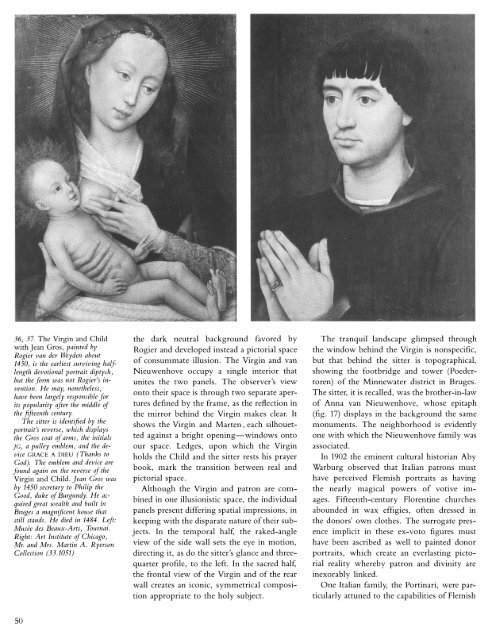Early Flemish Portraits 1425-1525: The Metropolitan Museum of Art ...
Early Flemish Portraits 1425-1525: The Metropolitan Museum of Art ...
Early Flemish Portraits 1425-1525: The Metropolitan Museum of Art ...
Create successful ePaper yourself
Turn your PDF publications into a flip-book with our unique Google optimized e-Paper software.
36, 37. <strong>The</strong> Virgin and Child<br />
with Jean Gros, painted by<br />
Rogier van der Weyden about<br />
1450, is the earliest surviving halflength<br />
devotional portrait diptych,<br />
but theform was not Rogier's invention.<br />
He may, nonetheless,<br />
have been largely responsible for<br />
its popularity after the middle <strong>of</strong><br />
the fifteenth century.<br />
<strong>The</strong> sitter is identified by the<br />
portrait's reverse, which displays<br />
the Gros coat <strong>of</strong> arms, the initials<br />
JG, a pulley emblem, and the device<br />
GRACE A DIEU (Thanks to<br />
God). <strong>The</strong> emblem and device are<br />
found again on the reverse <strong>of</strong> the<br />
Virgin and Child. Jean Gros was<br />
by 1450 secretary to Philip the<br />
Good, duke <strong>of</strong> Burgundy. He acquired<br />
great wealth and built in<br />
Bruges a magnificent house that<br />
still stands. He died in 1484. Left:<br />
Musee des Beaux-<strong>Art</strong>s, Tournai.<br />
Right: <strong>Art</strong> Institute <strong>of</strong> Chicago,<br />
Mr. and Mrs. Martin A. Ryerson<br />
Collection (33.1051)<br />
the dark neutral background favored by<br />
Rogier and developed instead a pictorial space<br />
<strong>of</strong> consummate illusion. <strong>The</strong> Virgin and van<br />
Nieuwenhove occupy a single interior that<br />
unites the two panels. <strong>The</strong> observer's view<br />
onto their space is through two separate apertures<br />
defined by the frame, as the reflection in<br />
the mirror behind the Virgin makes clear. It<br />
shows the Virgin and Marten, each silhouetted<br />
against a bright opening-windows onto<br />
our space. Ledges, upon which the Virgin<br />
holds the Child and the sitter rests his prayer<br />
book, mark the transition between real and<br />
pictorial space.<br />
Although the Virgin and patron are combined<br />
in one illusionistic space, the individual<br />
panels present differing spatial impressions, in<br />
keeping with the disparate nature <strong>of</strong> their subjects.<br />
In the temporal half, the raked-angle<br />
view <strong>of</strong> the side wall sets the eye in motion,<br />
directing it, as do the sitter's glance and threequarter<br />
pr<strong>of</strong>ile, to the left. In the sacred half,<br />
the frontal view <strong>of</strong> the Virgin and <strong>of</strong> the rear<br />
wall creates an iconic, symmetrical composition<br />
appropriate to the holy subject.<br />
<strong>The</strong> tranquil landscape glimpsed through<br />
the window behind the Virgin is nonspecific,<br />
but that behind the sitter is topographical,<br />
showing the footbridge and tower (Poedertoren)<br />
<strong>of</strong> the Minnewater district in Bruges.<br />
<strong>The</strong> sitter, it is recalled, was the brother-in-law<br />
<strong>of</strong> Anna van Nieuwenhove, whose epitaph<br />
(fig. 17) displays in the background the same<br />
monuments. <strong>The</strong> neighborhood is evidently<br />
one with which the Nieuwenhove family was<br />
associated.<br />
In 1902 the eminent cultural historian Aby<br />
Warburg observed that Italian patrons must<br />
have perceived <strong>Flemish</strong> portraits as having<br />
the nearly magical powers <strong>of</strong> votive images.<br />
Fifteenth-century Florentine churches<br />
abounded in wax effigies, <strong>of</strong>ten dressed in<br />
the donors' own clothes. <strong>The</strong> surrogate presence<br />
implicit in these ex-voto figures must<br />
have been ascribed as well to painted donor<br />
portraits, which create an everlasting pictorial<br />
reality whereby patron and divinity are<br />
inexorably linked.<br />
One Italian family, the Portinari, were particularly<br />
attuned to the capabilities <strong>of</strong> <strong>Flemish</strong><br />
50

















